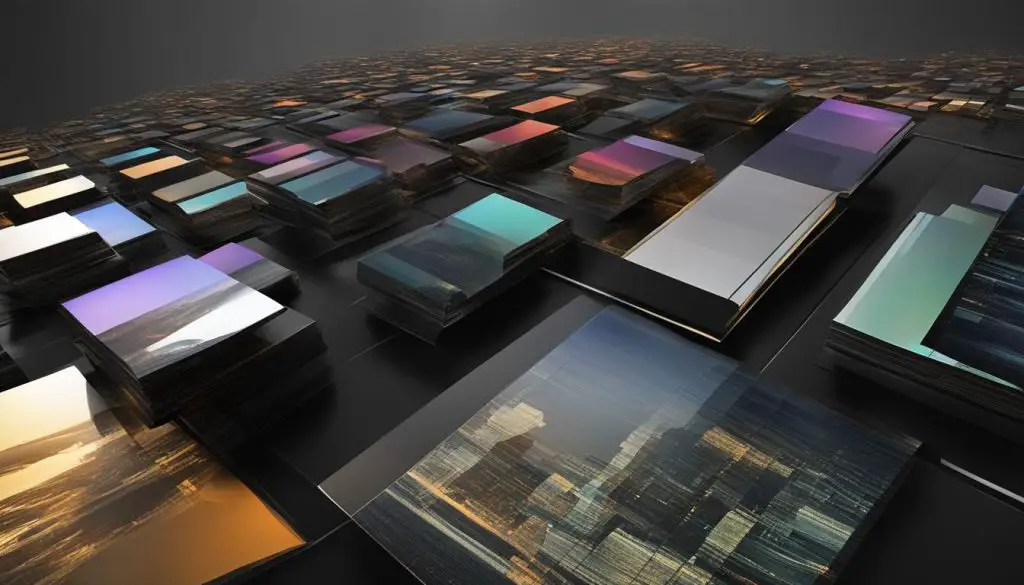For graphic designers and photographers, the ability to work with multiple layers in an image file is essential. One file format that offers this functionality is the TIFF file format. In this article, we will explore whether a TIFF file can indeed store multiple layers and the benefits it brings to image editing and manipulation.

Key Takeaways:
- A TIFF file is a raster image format that can store high-quality images while preserving detail and color.
- TIFF files can support multiple layers and transparency, making them ideal for graphic designers and photographers.
- TIFF files have several benefits, including lossless compression, support for various color models, and high-quality printing.
- However, TIFF files tend to be larger in size and may not be as suitable for web browsers compared to other file formats.
- When it comes to professional printing and extensive image editing, TIFF files are often the preferred choice.
What is a TIFF file?
A TIFF file, or tagged image file format, is a type of graphic file format used for images. It is a raster format that uses lossless compression and can support multiple layers and transparency. TIFF files can be edited and resaved without losing quality, making them a preferred choice for graphic designers and photographers.
TIFF files are widely recognized and supported by various software applications, including image editing programs like Adobe Photoshop. They are commonly used in industries such as printing, publishing, and advertising, where high-quality and detailed images are essential.
One of the key features of TIFF files is their ability to store multiple layers. Layers allow for the separation and organization of different elements within an image, such as text, graphics, and effects. This makes it easier to edit and manipulate specific parts of the image without affecting other elements. With the use of layers, graphic designers and photographers have greater control and flexibility when working with TIFF files.
“TIFF files have become a standard in the industry due to their versatility and ability to preserve image quality. The support for multiple layers allows for seamless editing and manipulation, making TIFF files an invaluable tool for professionals.”
What is a TIFF file?
TIFF files are a popular choice for archiving and preserving high-quality images due to their lossless compression. Lossless compression means that no data is lost during the compression process, ensuring that the image retains its original quality when saved in a TIFF format. This makes TIFF files ideal for projects that require extensive editing or reprints in the future.
In summary, a TIFF file is a widely used graphic file format that supports multiple layers and transparency. It is a preferred choice for graphic designers and photographers due to its lossless compression and ability to preserve high-quality images. Whether for printing, publishing, or editing purposes, TIFF files offer the flexibility and control needed to create stunning visual content.
Benefits of TIFF files
TIFF files offer several advantages that make them a preferred choice for graphic designers and photographers. Here are some of the key benefits:
- Lossless Compression: TIFF files use lossless compression, which means that no data is lost during the compression process. This ensures that the image quality remains unchanged, making TIFF files suitable for high-quality printing and editing.
- Support for Multiple Layers: One of the major benefits of TIFF files is their ability to support multiple layers. This feature allows for easy editing and manipulation of images, making it an ideal format for complex graphic designs and photo retouching.
- Transparency: TIFF files also support transparency, which means that you can have areas of an image that are completely transparent or partially transparent. This is particularly useful when working with graphics or images that need to be overlaid on other elements.
- Wide Color Support: TIFF files can support a wide range of color models, including RGB, CMYK, Lab, and grayscale. This flexibility allows for accurate color reproduction and ensures that the final printed or displayed image matches the original.
In summary, the benefits of TIFF files include lossless compression, support for multiple layers and transparency, and wide color model support. These features make TIFF files a versatile and powerful format for graphic design, photography, and professional printing.
Table: Comparing TIFF with other file formats
| File Format | Compression | Support for Layers | Transparency | Color Models |
|---|---|---|---|---|
| TIFF (.tiff) | Lossless | Yes | Yes | RGB, CMYK, Lab, grayscale |
| JPEG (.jpg) | Lossy | No | No | RGB |
| PNG (.png) | Lossless | No | Yes | RGB |
This table compares TIFF files with other popular file formats, namely JPEG and PNG. While JPEG files are smaller in size and widely supported, they do not support multiple layers and transparency like TIFF files do. PNG files offer transparency support but have limitations when it comes to image resolution and quality. TIFF files, on the other hand, provide a comprehensive set of features that make them ideal for professional printing, graphic design, and photography.
Downsides of TIFF Files
While TIFF files offer numerous advantages, they also come with a few downsides that users should be aware of. One of the main drawbacks of TIFF files is their large file size. Due to their lossless compression and support for multiple layers, TIFF files can be significantly larger than other file formats, such as JPEG or PNG. This can make them cumbersome to work with, especially when it comes to sharing or uploading them on the web.
Another potential downside of TIFF files is their limited support in web browsers. Unlike popular image formats like JPEG or PNG, TIFF files may not be universally supported by all web browsers. This can pose challenges when sharing or displaying TIFF images online, as some users may not be able to view them properly without the use of specific plugins or software.
However, it’s important to note that the limitations of TIFF files are often outweighed by their unique benefits, especially in professional settings. The ability to maintain image quality, support multiple layers, and preserve transparency make TIFF files an excellent choice for graphic designers, photographers, and those who require high-quality printing. While other file formats may be more suitable for web use, TIFF files continue to be the preferred option for professionals who prioritize image fidelity and editing capabilities.
| Downsides of TIFF Files | Details |
|---|---|
| Large file size | Due to lossless compression and support for multiple layers, TIFF files can be significantly larger than other formats, making them less suitable for web use. |
| Limited support in web browsers | Not all web browsers support TIFF files, which can result in compatibility issues when sharing or displaying images online. |

Despite these downsides, TIFF files remain a valuable asset for professionals in the graphic design and photography industries. The ability to store multiple layers and maintain image quality makes TIFF a reliable choice for projects that require intricate editing and high-resolution printing. It is important for users to weigh the advantages and disadvantages of TIFF files to determine if they are the right fit for their specific needs.
TIFF vs. other file formats
When comparing TIFF files to other popular file formats like JPEG and PNG, it’s important to consider the specific needs and requirements of your project. While JPEG files are more compact and widely supported by web browsers, they lack the ability to support multiple layers and transparency like TIFF files do. This makes TIFF files a preferred choice for graphic designers and photographers who need to work with complex images and require the highest level of image quality.
On the other hand, PNG files offer smaller file sizes and support transparency, but they do not offer the same level of image resolution and quality as TIFF files. PNG files are often used for web graphics and online platforms where file size is a concern. However, if you are focusing on professional printing and editing, TIFF files are the go-to option due to their lossless compression, support for various color models, and ability to maintain exceptional image quality.
To further illustrate the differences between these file formats, consider the following comparison:
| Feature | TIFF | JPEG | PNG |
|---|---|---|---|
| Lossless Compression | Yes | No | No |
| Multiple Layers Support | Yes | No | No |
| Transparency Support | Yes | No | Yes |
| File Size | Larger | Smaller | Smaller |
| Image Quality | Excellent | Good | Good |
As shown in the table, TIFF files excel in terms of lossless compression, support for multiple layers, and transparency. However, they do come with larger file sizes compared to other formats. It’s essential to assess your specific needs and consider the trade-offs between file size and image quality when choosing the right format for your project.
Conclusion
In conclusion, the TIFF file format is a valuable tool for graphic designers and photographers due to its ability to store multiple layers. This feature allows for easier editing and manipulation of images, making it a preferred choice for professionals in the industry.
Working with TIFF layers provides the flexibility to make precise adjustments to different elements of an image without affecting the overall composition. It allows for better control and creativity in the editing process, resulting in high-quality and polished final products.
Whether it’s adjusting colors, adding special effects, or fine-tuning details, editing TIFF file layers offers a level of precision and control that is crucial in professional graphic design and photography work.
However, it’s important to note that TIFF files can be large in size and may not be ideal for web use due to limited browser support. In such cases, other file formats like JPEG or PNG may be more suitable. Nevertheless, when it comes to preserving quality and having the flexibility to work with multiple layers, the TIFF file format remains a top choice for graphic professionals.
